News
Ground Systems Research Center
Outline
The Ground System Research Center conducts research on fire arms, ammunition, ballistic and blast-resist structures, vehicles, vehicular equipment, engineer equipment, personal equipment, CBRN※ defense technology, etc.
※CBRN : Chemical, Biological, Radiological, Nuclear
Welcome to GROUND SYSTEM RESEARCH CENTER(click the link to the ATLA Official Channel on YouTube)
Systems Division
Research, Test and Evaluation on Fire Arm Systems, Ammunition Systems and Combat Vehicle Systems, and Research on radiological, chemical, biological defense technology, etc.
Ballistics Research Division
Research on fire arms, ammunition, warheads, ballistic and blast resistant structure, survivability analysis, etc.
Mobility Research Division
Research on performance of vehicular subsystems and engineer equipment such as suspension, transmission, engine and land mine detector.
Research
Research on EMP Ammunition
The research on the technology of EMP※ ammunition, which causes powerful electro-magnetic pulse, is conducted to make the capability of sensor and information system in enemy be suppressed temporary or permanently without any direct destruction caused by conventional ammunition, missiles, etc.
※EMP : Electro-Magnetic Pulse
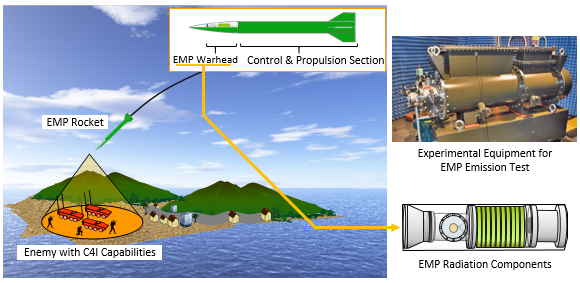
Research on Multi-Purpose Ammunition
We conduct the applied research on multi-purpose ammunition, which can be fired from combat vehicles, that would demonstrate the most appropriate effect in accordance with the target for action, in spite of a single type of ammunition. By pre-setting up the fuze mode (time function, impact action, delay action), the ammunition can deal with various targets such as assembled target, non-line-of-sight target and hard structure.
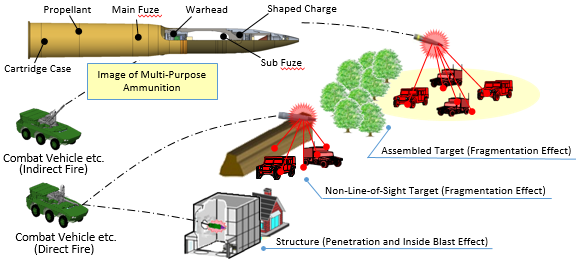
Research on Air-Cooled System of In-Hub Motor
We conduct the research on air-cooled in-hub motor for combat vehicles that contributes to enhance survivability and maintainability in troop, and weight reduction, while sustaining the capability equivalent to that of water cooled in-hub motor, which is considered as one of the results of the previous research on the Lightweight Combat Vehicle System.
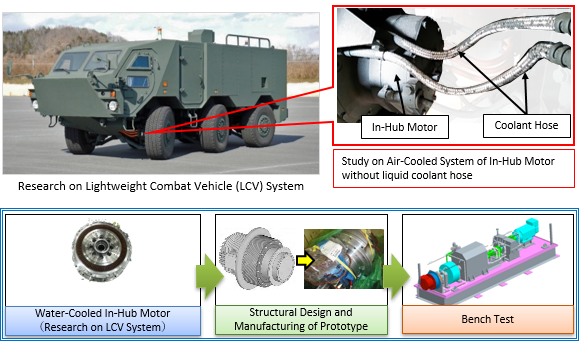
Research on Surrounding Environ mental Recognition Technology for Unmanned Ground Vehicle
In this research, we develop environmental recognition technologies (e.g. position estimation, 3D mapping and object recognition) which are necessary for multiple UGVs to perform specific missions by autonomous driving or remote control in defense-specific environments such as GPS-denied environments.
This research is conducted as a Japan-Australia cooperative project.
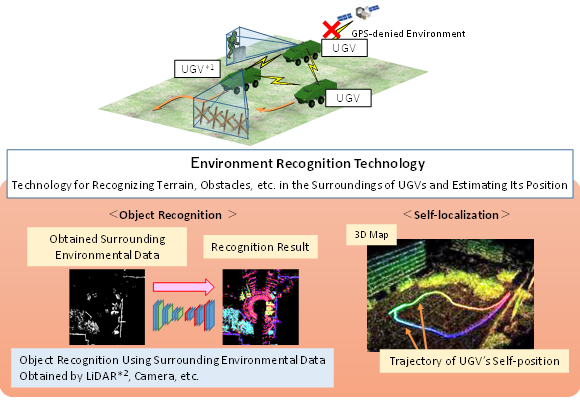
※1 UGV : Unmanned Ground Vehicle
※2 LiDAR : Light Detection and Ranging
Research on CBRN※ Defense Technology
※CBRN : Chemical, Biological, Radiological, Nuclear
In order to fulfill the aim, which is to respond rapidly to dilute gaseous chemical agents that are difficult to detect with conventional detection paper, the adsorption ability and functionalization of nanofibers are investigated by conpounding dyes and nanofibers, etc. In addition, further research is conducted to develop a simple microbial sensor that is inexpensive and excellent in store stability.

Protective clothing and masks are being evaluated not only in terms of material performance but also its performance under conditions much more similar to those in real environments using equipment that simulates human breathing and walking. Furthermore, in order to improve the efficiency of decontamination, reaction analysis is implemented by using the latest instrumental analysis technology.
The research on protective clothing and masks is conducted as a Japan-United Kingdom cooperative project.
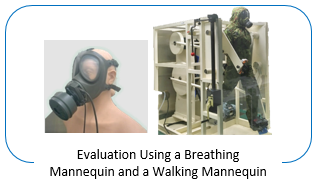
Research on Electromagnetic Railgun
We have been conducting a series of research on electromagnetic railgun which accelerate projectile using electric energy. The electromagnetic railgun can launch projectile in extremely high muzzle velocity compared with conventional guns using energy of gun powder, and is expected to realize greater penetration power and longer shooting range.
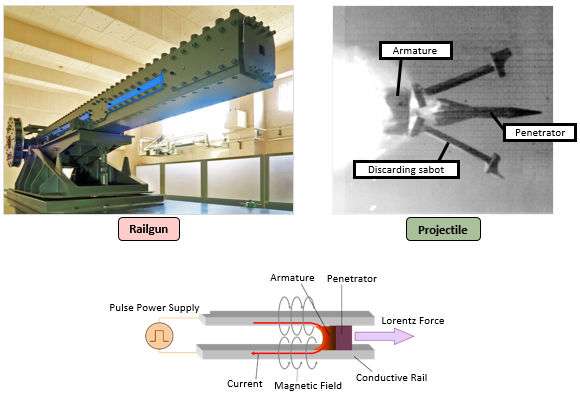
Research on Rapid Add On Armor
In the SDF, there are possibilities that the ballistic performance of unarmored vehicles have to be strengthened depending on the environment in which they are used. As a consequence, to deal with these various circumstances, we conduct research on rapid add on armor, which can improve ballistic performance of unarmored vehicles(e.g. 1½ ambulance) rapidly and easily.
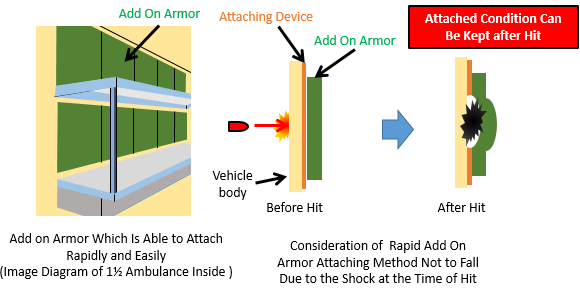
Research on Advanced Anti-Surface Warhead Technology
The objective of “Advanced anti-surface warhead technology” is to develop warheads for guided missiles to effectively attack warships and military vehicles deployed around/on a range of islands and its surrounding sea area. As a project, we conduct the research on a tandem type warhead for anti surface ships and a multi EFP※ type warhead for anti ground vehicles.
※EFP : Explosively Formed Projectile
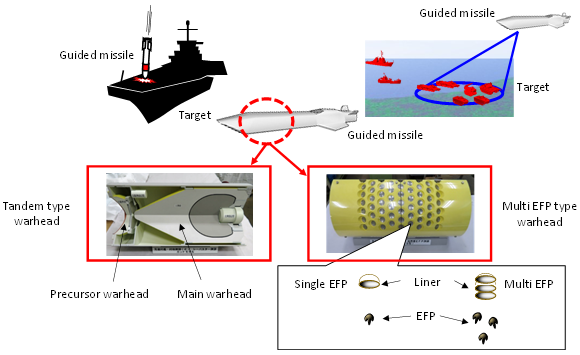
Research on Exploding Foil Initiator and Electronic Safety Arming Devise
We conduct research on initiating technology combined with EFI and ESAD. While EFI※1 can safely initiate warheads without using primary explosive, ESAD※2 can be applied to various initiating functions with electronic control.
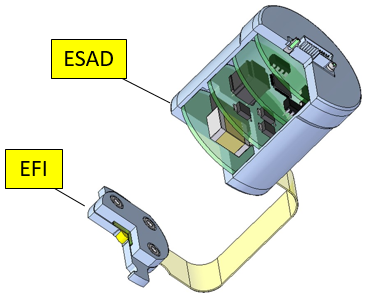
※1 EFI : Exploding Foil Initiator
※2 ESAD : Electronic Safety Arming Devise
Littoral Environment Vehicle Simulator (LEVS)
Based on the developed simulation methods for ground vehicles, further research on the littoral environment vehicle simulator is conducted in order to construct the simulator for evaluating the mobility of various ground vehicles like amphibious vehicles under diverse environment, on the land, water, shore like coral reefs . This simulator is capable of executing both real-time simulations to evaluate maneuverability including the driver, and non-real-time simulations to precisely calculate the behavior of the vehicle by spending adequate run-time.
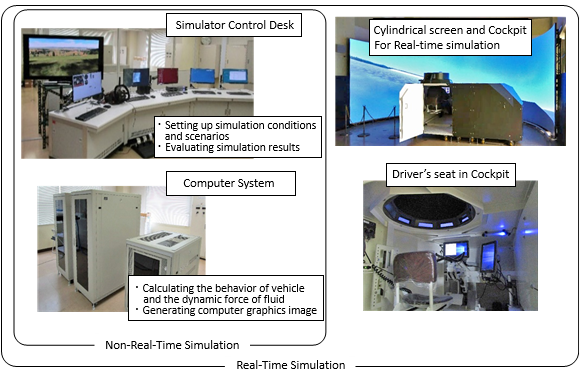
Research on Modular High Power Density Hybrid Propulsion Technology
The research on parallel-hybrid system※ for wheeled vehicles is conducted in order to enable silent run, silent watch, and electric supply inside and outside the vehicle.
This research is conducted as a Japan-U.S. cooperative project.
※parallel-hybrid system : hybrid system driven by both engine and electric motor
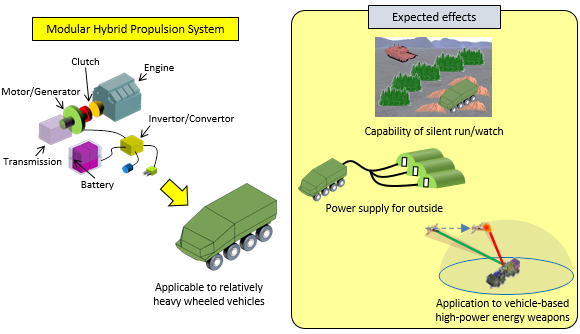
Research on Unmanned Airborne-type Reconnaissance Equipment (UARE)
The research is conducted on the Unmanned Airborne Type Reconnaissance Equipment, which is compact and lightweight, with high-precision self-position estimation and detailed under-ground investigation functions, to implement reconnaissance minefield and enemy observation position more safely to minimize the risks of personnel.
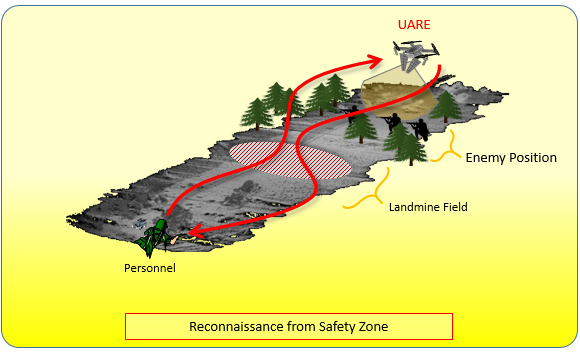
Research on Components of the Future Light-weight Bridge
This research is conducted pertaining to utilize the light and highly strong CFRP※ for the main structural parts of the military bridges. The objective of the research is to achieve higher performance for the assault bridge used by the SDF. As a result, the unit can act rapidly at the place where a bridge was collapsed in any emergency cases or a large-scale disaster.
※CFRP : Carbon Fiber Reinforced Plastics
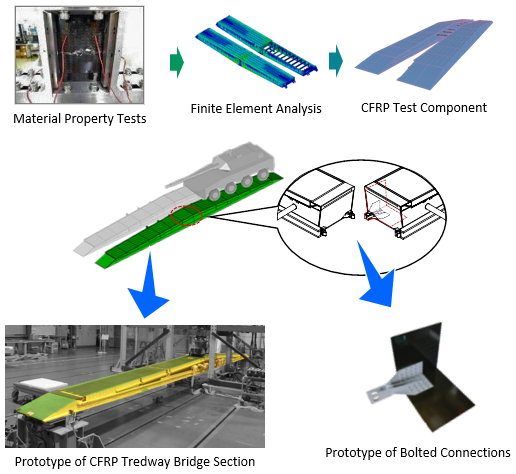
Test
Firing Test, Protection Test
Fire power and protection of combat vehicles are tested and evaluated by firing test, ballistic/blast-resistant tests, etc.
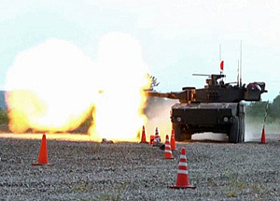
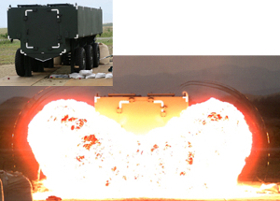
Mobility Test
Mobility of combat vehicles is tested and evaluated by acceleration test, maximum speed test, hill climbing test, etc.




